Understanding Pool Water Chemistry
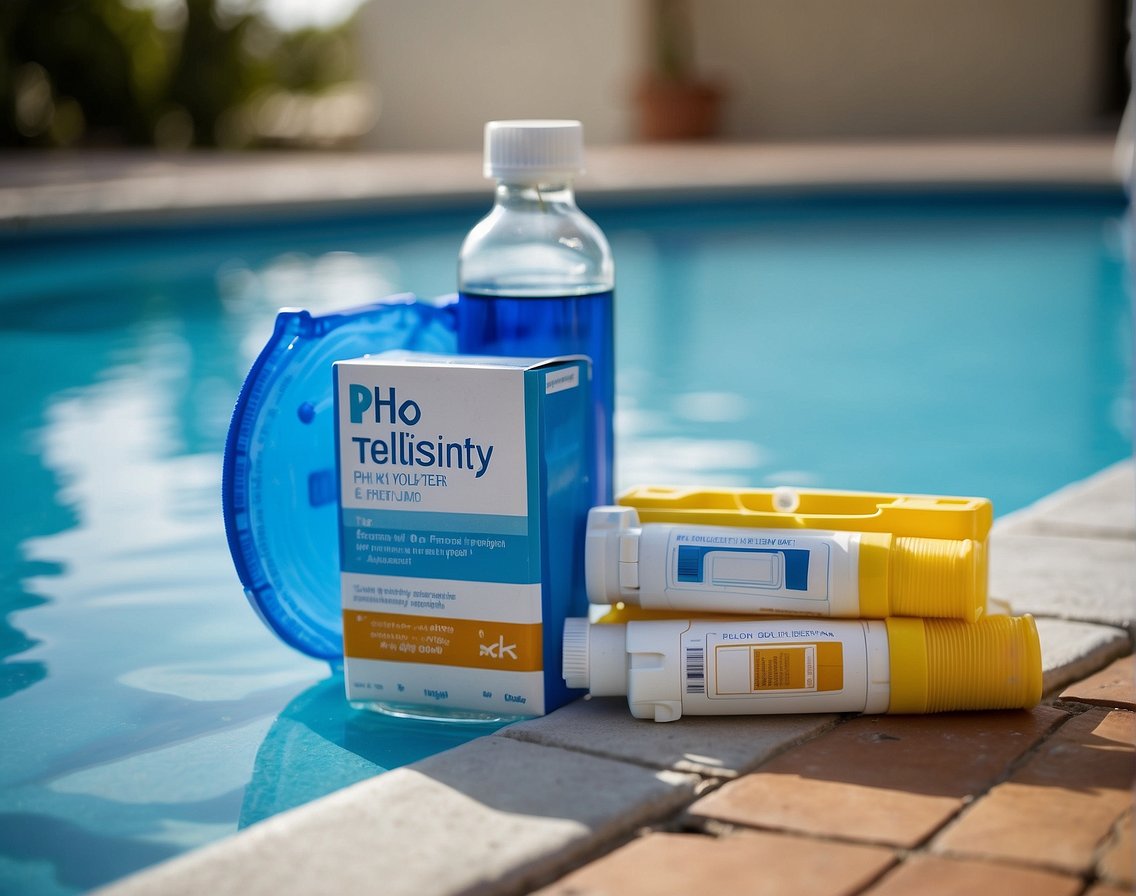
When maintaining our swimming pool, we prioritize water chemistry to ensure a safe and pleasant swimming environment. The primary components we focus on include:
- pH: Reflects how acidic or basic our pool water is, with a range of 7.2 to 7.8 being ideal. If pH is outside this range, swimmers may experience discomfort, and our pool equipment could corrode or scale.
- Total Alkalinity (TA): Functions as a buffer for pH, helping to stabilize it. TA should typically be between 80 and 120 ppm (parts per million). Proper TA levels prevent rapid pH fluctuations.
- Chlorine: Our primary sanitizer, it eliminates pathogens and bacteria. Free Chlorine levels ought to be between 1 and 3 ppm. Combined Chlorine (chloramines) levels should remain low, as high levels can cause irritation and a strong chlorine odor.
- Cyanuric Acid: Protects chlorine from UV degradation, effectively extending its sanitizing lifespan. Ideal levels should be between 30 and 50 ppm to balance protection while preventing chlorine lock, where chlorine becomes less effective.
We also monitor:
- Total Dissolved Solids (TDS): High TDS levels, usually above 1500 ppm, can reduce the efficacy of our pool chemicals and might necessitate water replacement.
- Water Balance: Encompasses all these elements and more, including calcium hardness. Maintaining balance is crucial to protect the pool surface and equipment from damage.
To prevent algae and ensure the health of our swimmers, adherence to these parameters is essential. Regular testing and adjustment of pool chemicals are fundamental practices for us to keep our pool water in perfect balance.
Maintaining Pool Water Balance
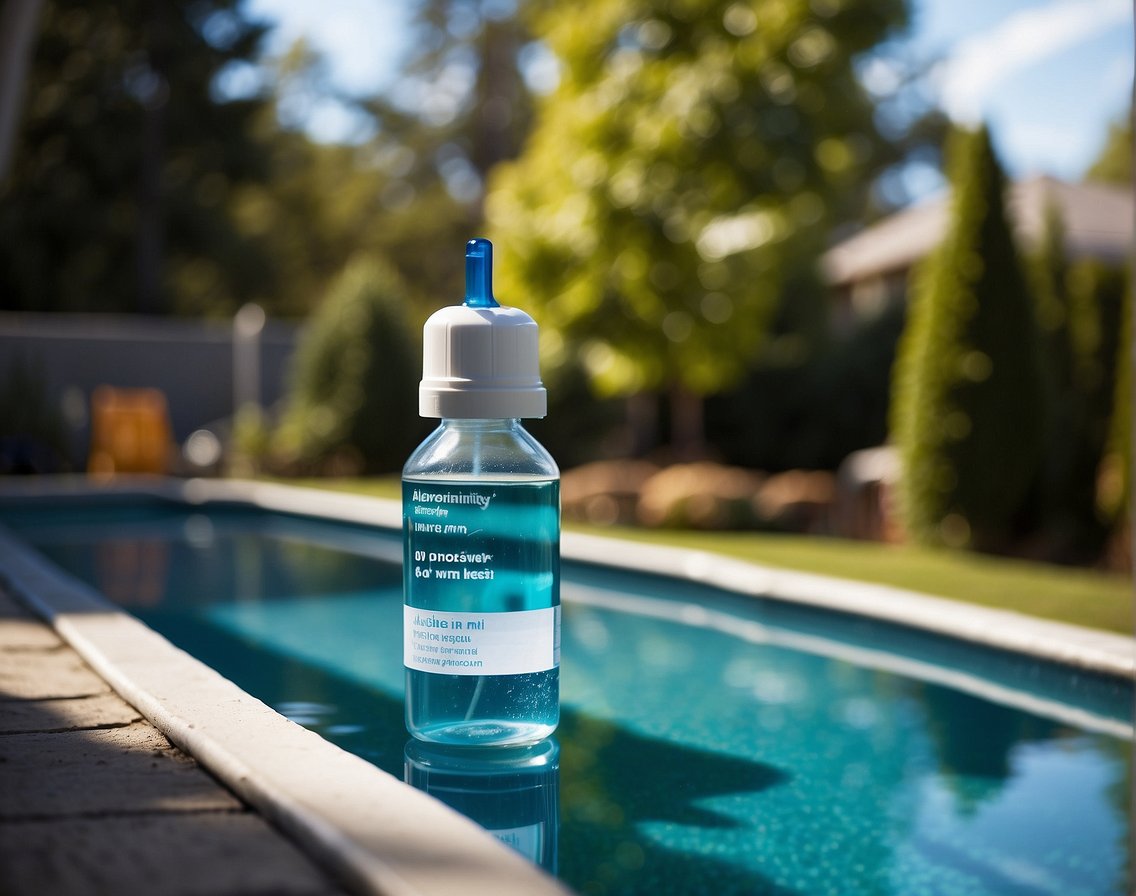
We must regularly monitor and adjust pool water balance to ensure a safe and comfortable swimming environment. Proper balance prevents corrosion, scale formation, and bacteria growth.
Addressing Alkalinity Levels
To maintain alkalinity, we often use an alkalinity increaser, typically sodium bicarbonate, to raise alkalinity if levels are low. When levels are high, adding muriatic acid or dry acid helps bring it back into the suggested range of 80-120 parts per million (ppm).
- To Increase Alkalinity: We add sodium bicarbonate in the required quantities, following the manufacturer’s guidelines.
- To Decrease Alkalinity: Muriatic acid or dry acid is carefully dosed into the pool water.
Managing pH Levels
The pH level is a crucial aspect of pool water chemistry, with an ideal range between 7.4 and 7.6.
- To Raise pH: We can add a pH increaser like soda ash according to the product instructions.
- To Lower pH: A pH decreaser such as muriatic acid is dosed into the pool.
Maintaining the ideal pH levels ensures that sanitizers work effectively and provides comfort for swimmers.
Controlling Calcium Hardness
Calcium hardness measures the amount of dissolved calcium in the water, and it’s essential for preventing damage to the pool and ensuring water clarity.
- Ideal range for calcium hardness: 200-400 ppm
| Calcium Levels | Action to Take |
|---|---|
| Below 200 ppm | Add a calcium increaser |
| Above 400 ppm | Dilute the pool with soft water or use a commercial remover |
Regular pool maintenance includes these adjustments to uphold the overall pool water balance for a clean and enjoyable swimming space.
Troubleshooting Common Pool Water Problems
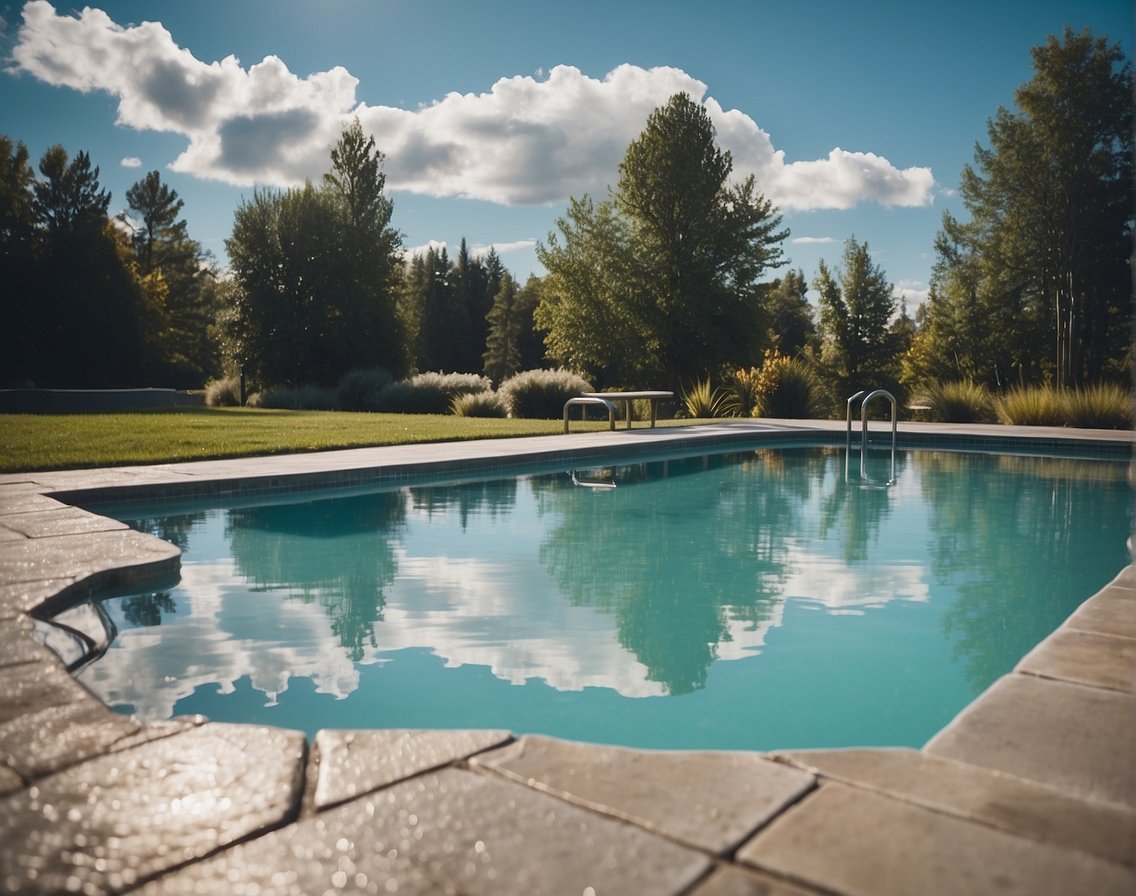
In managing pool water chemistry, we must systematically address issues like algae growth and imbalanced water, which can lead to cloudiness and scale. Proper use of testing kits and understanding the right chemical adjustments are crucial.
Combating Algae and Contaminants
Controlling algae and contaminants is pivotal for a clean swimming environment. We start by regularly checking chlorine levels with a test kit or test strips, as insufficient chlorine can lead to algae and bacteria proliferation. If algae are present, we use an algaecide and ensure chlorine levels are maintained at 1-3 ppm for effectiveness. It is also helpful to routinely add a shock treatment, which significantly raises the chlorine level for a short period to kill off contaminants.
Furthermore, we often incorporate flocculant to clump together particles that algae feed on, making them easier to filter out. This proactive approach aids in preventing the growth of these unwanted organisms and keeping the pool sanitary.
Resolving Cloudy Water and Scale Formation
Cloudy water and scale formation can be due to an imbalance of pH and calcium hardness. We tackle cloudy water by first testing and adjusting the pH to the ideal range of 7.4-7.6 using sodium bicarbonate to raise pH if it’s too acidic or sodium bisulfate to lower pH if it’s too basic.
Scale forms when there’s high calcium hardness, and to address this, we ensure the calcium levels aren’t above 200-400 ppm, adding calcium chloride if there’s a deficit. Moreover, to prevent the therefore corrosive or scaling conditions, keeping a balanced alkalinity between 80-120 ppm is essential. Balancing these levels not only resolves current issues but also protects against corrosion of pool equipment and surfaces, as well as eye irritation for swimmers.
Pool Equipment and Chemicals
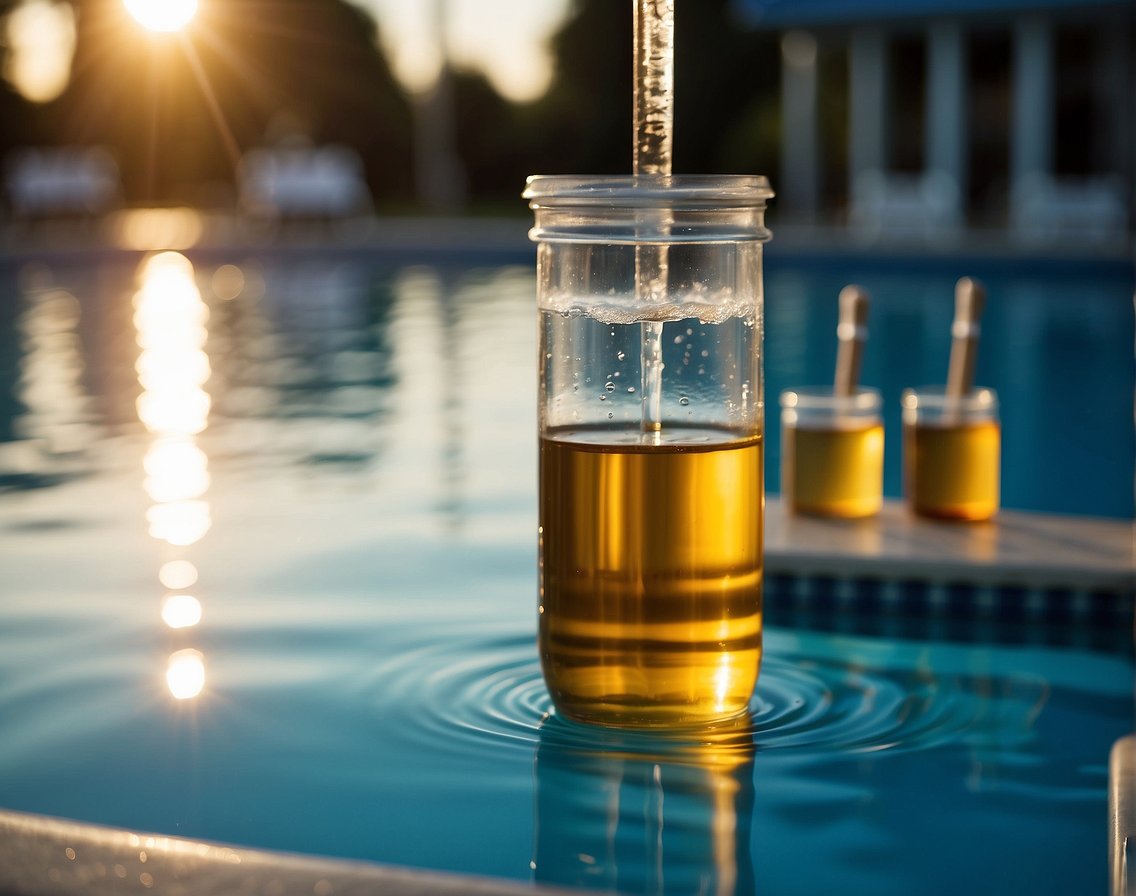
Pool maintenance requires a blend of the right equipment and chemicals. Crucial to this is understanding how they impact your pool’s alkalinity.
Pool Filters and Alkaline Materials
We use pool filters to remove impurities from the water, ensuring it remains healthy and clear. Over time, filters can gather alkaline material, which may increase water pH. We monitor and maintain these filters to prevent such shifts.
Chlorine Tablets and Stabilizers
Chlorine tablets are essential for sanitizing pool water by killing bacteria and algae. Adding a stabilizer prolongs chlorine’s effectiveness, particularly under UV light. It’s essential to balance these chemicals to avoid fluctuations in alkalinity.
Soda Ash and Muriatic Acid
Soda ash serves to elevate pH levels when they fall below the ideal range. Conversely, muriatic acid lowers alkalinity. We carefully dose our pools with these substances to maintain a neutral pH balance.
Water Features Management
Water features add aesthetics but require attention because they can alter water chemistry. We ensure that the features do not introduce additional alkaline elements that would disrupt the balance.
To summarize:
| Equipment/Chemicals | Function | Impact on Alkalinity |
|---|---|---|
| Pool Filters | Remove impurities | Can increase pH |
| Chlorine Tablets | Sanitize water | Stabilize pH; use with care |
| Stabilizer | Prolong chlorine’s effectiveness | Helps maintain pH balance |
| Soda Ash | Increase pH levels | Raises alkalinity |
| Muriatic Acid | Lower pH levels | Lowers alkalinity |
| Water Features | Add to pool aesthetics and value | Can increase pH |
We maintain a tight control over these variables to ensure our pool water is perfectly balanced.
Routine Pool Testing and Maintenance
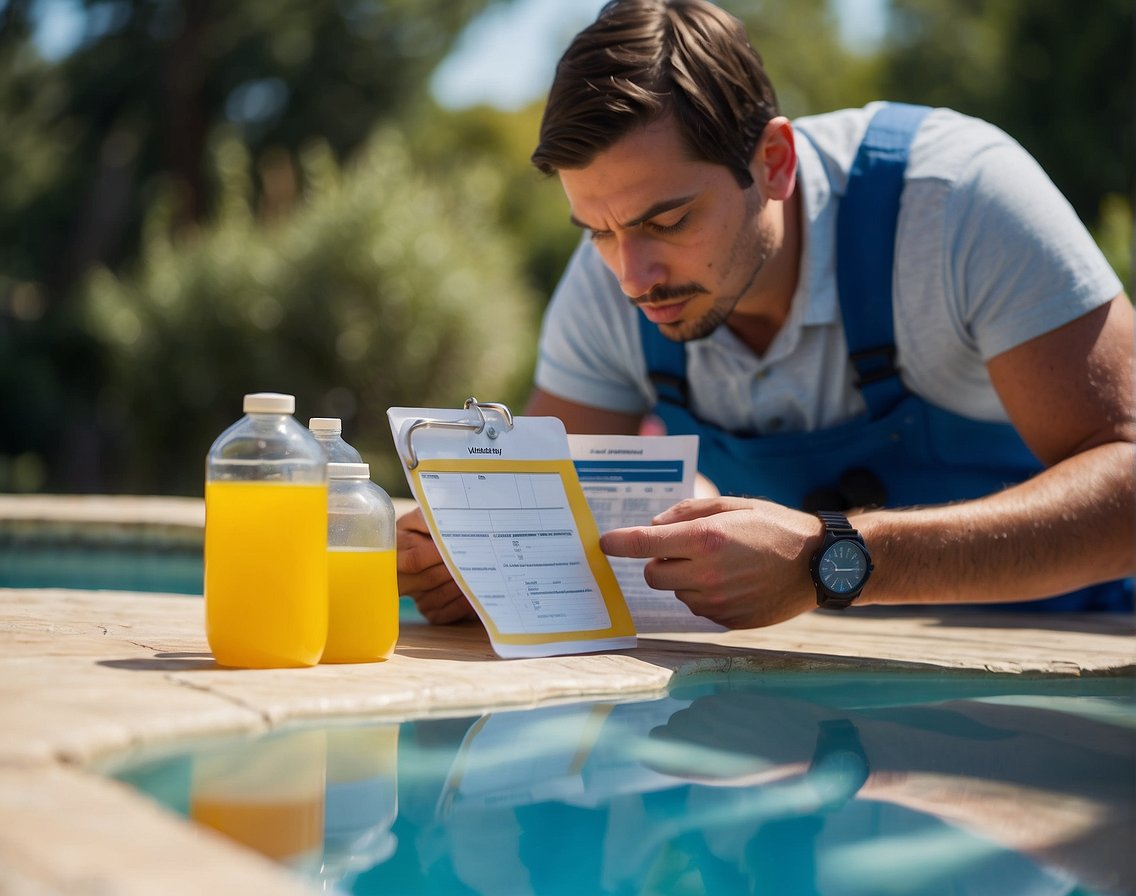
In managing a pool’s water chemistry, regular testing is crucial. We often start by assembling a reliable testing kit, including tests for pH, free chlorine, total chlorine, bromine, cyanuric acid levels, and total alkalinity. It’s pertinent for us to ensure these kits are up-to-date and of good quality, as this will dictate the accuracy of our results.
Testing Frequency:
We recommend testing the pool water:
- Daily for sanitizer levels (such as chlorine and bromine)
- Weekly for pH and total alkalinity
- Monthly for cyanuric acid, magnesium, and calcium hardness
- Seasonally or during significant temperature changes, which can cause fluctuations in pool chemistry
Temperature’s Role:
Temperature significantly affects chemical dissolution and the efficacy of sanitizers, thus we often test the water when there’s a noticeable change in weather conditions.
Maintaining pH and Alkalinity:
The ideal pH range for pool water is 7.4 to 7.6.
Here’s a quick reference table:
| Pool Feature | Ideal Range |
|---|---|
| pH | 7.4 – 7.6 |
| Free Chlorine | 1-3 ppm |
| Total Chlorine | 1-3 ppm |
| Bromine | 3-5 ppm |
| Cyanuric Acid | 30-50 ppm |
| Total Alkalinity | 80-120 ppm |
Pool water too acidic can lead to skin and eye irritation and erode pool components, particularly if they’re made of vinyl. On the other hand, high alkalinity can make pH levels challenging to adjust.
Chemical Adjustments:
For adjustments, we use:
- Algaecides to prevent algae growth
- pH increasers or pH decreasers to balance pH levels
- Bicarbonates to adjust total alkalinity
We stress on consulting with a pool professional if our testing highlights persistent issues or if we are unsure about the correct chemical adjustments to make. Proper pool testing and chemical balancing prevent damage to pool equipment, ensure the comfort and safety of swimmers, and prolong the overall lifespan of the pool.
Frequently Asked Questions
In addressing pool water chemistry, it’s crucial to understand the interaction between alkalinity and other chemicals. We’ve compiled a set of frequently asked questions to clarify this connection and assist in maintaining a healthy pool environment.
How can I correct the alkalinity level in my pool if it’s too high or too low?
If our pool’s alkalinity is too high, we can add an acid, like muriatic acid or sodium bisulfate, to lower it. Conversely, to raise low alkalinity, we use sodium bicarbonate (baking soda). We must ensure to follow the manufacturer’s dosage recommendations closely, adjusting gradually, and retesting the water after the chemicals have been properly circulated.
What role does alkalinity play in maintaining the overall chemical balance of pool water?
Total Alkalinity (TA) acts as a buffer for the pH level, helping to stabilize it against sudden changes. It’s key in protecting pool surfaces and equipment, as it assists in sustaining the effectiveness of chlorine and other sanitizers, ensuring our pool’s water chemistry remains in harmony.
What are the consequences of having unbalanced alkalinity levels in pool water?
Unbalanced alkalinity can lead to a variety of issues. Low alkalinity may cause etching of pool surfaces, corrosion of metal fittings, and erratic pH levels. High alkalinity can lead to cloudy water, scaling on pool surfaces and equipment, reduced sanitizer effectiveness, and a consistently high pH that’s difficult to adjust.
Can you explain the relationship between pH levels and alkalinity in pool water?
Alkalinity and pH levels in pool water are interconnected; alkalinity is often considered a ‘pH buffer.’ If alkalinity is within the appropriate range, it helps to prevent dramatic pH swings. When the alkalinity is balanced, it’s much simpler to maintain the optimal pH level, which is typically between 7.4 and 7.6.
Which pool chemicals are affected by alkalinity, and how should they be balanced accordingly?
Chlorine, bromine, and other sanitizers are influenced by alkalinity. If the alkalinity is too high, chlorine becomes less effective. We must aim to first adjust the alkalinity to the recommended level before fine-tuning the sanitizer levels. This balances the chemicals and keeps the water clear and safe for swimmers.
What is the proper sequence for adding chemicals to balance pool water, including alkalinity?
We should adjust the total alkalinity first to establish a stable pH level base. After that, pH and chlorine levels can be corrected. This sequence ensures optimal conditions for chlorine efficiency and prevents the interaction of chemicals that can counteract each other. Always retest the water after adding chemicals and wait the suggested amount of time before adding different chemicals.
